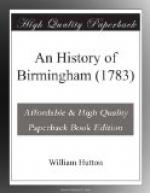The manor was the property of the Earls of Mercia, but whether their residence is uncertain.—The traces of a moat yet remain, which are triangular, and encircle a wretched farm-house of no note: one of the angles of this moat is filled up, and become part of Castle-lane; which proves that Ulverley went into disuse when Hogg’s-moat was erected: it also proves that the lane terminated here, which is about two hundred yards from the turnpike road. The great width of the lane, from the road to Ulverley, and the singular narrowness from thence to Hogg’s-moat, is another proof of its prior antiquity.
If we pursue our journey half a mile Farther along this lane, which by the way is scarcely passable, it will bring us to
HOGG’S-MOAT.
At Oltenend (Old Town) originally Odingsell’s-moat, now Hobb’s-moat, the ancient manor-house of Solihull, after it had changed its lords at the conquest. The property, as before observed, of Edwin Earl of Mercia, in the reign of Edward the the Confessor.
William the First granted the manor to a favourite lady, named Cristina, probably a handsome lass, of the same complexion as his mother; thus we err when we say William gave all the land in the kingdom to his followers—some little was given to those he followed.
This lady, like many of her successors, having tired the arms of royalty, was conveyed into those of an humble favourite; Ralph de Limesie married her, who became lord of the place, but despising Ulverley, erected this castle.
The line of Limesie continued proprietors four descents; when, in the reign of King John, it became the property of Hugh de Odingsells, by marrying a co-heiress.
The last of the Odingsells, in 1294, left four daughters, one of whom, with the lordship, fell into the hands of John de Clinton; but it is probable the castle was not inhabited after the above date, therefore would quickly fall to decay.
The moat is upon a much larger plan than Ulverley, takes in a compass of five acres, had two trenches; the outer is nearly obliterated, but the inner is marked with the strongest lines we meet with. This trench is about twenty feet deep, and about thirty yards from the crown of one bank to the other.
When Dugdale saw it, about a hundred and fifty years ago, the center, which is about two acres, where the castle stood, was covered with old oaks; round this center are now some thousands, the oldest of which is not more than a century; so that the timber is changed since the days of Dugdale, but not the appearance of the land.
The center is bare of timber, and exhibits the marks of the plough. The late Benjamin Palmer, Esq; a few years ago, planted it with trees, which are in that dwindling state, that they are not likely to grow so tall as their master[7].




